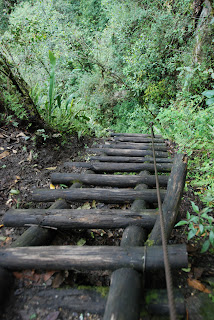
One of the things I loved about Ollantaytambo was the quiet, small town atmosphere. In this picture you see an Inca courtyard. Ollantaytambo is a wonderfully preserved Inca settlement. The streets and homes have been maintained in the same style as they were built by the Incas. One of the ways that the Inca designed homes was a "cancha", or block of homes. This is an example---the opening from the street opens onto a courtyard, off of which are 4 houses. Our guidebook told of a family who opened their home for people to see. It wasn't easy to find, but I followed the directions and found the house.
Notice in the picture the canal down the middle of the courtyard---stone lined from Inca times. In the background on the mountain you can see ruins of Inca storehouses and the Inca face that I posted in the previous post. Grant and I climbed part way up that mountain---to the storehouses on the previous day. It is where the cactus I posted was. I also found some tiny shells on the side of the mountain. They looked like tiny sea shells.

These skulls were on the mantle inside the house pictured above. I spoke in my limited Spanish to the woman, who told me they were skulls of her Inca ancestors. She was very personable and welcoming. I wish my Spanish had been better so I could have asked my many questions.

The husband was preparing a fire to cook the cuy, guinea pigs. The cuy seemed so happy living in the house with the family. See the one perched on the stone overlooking the fire? He doesn't know what his future holds....

The woman shows me her bowl of cuy ready to be roasted. "Cuy al horno" is a dish available in the restaurants. I didn't want to try it.
This old dog was laying on these steps every time we walked by. He never lifted his head to check us out, even when I talked to him He reminded me of Champ, our 14 year old dog, who mostly sleeps these days.
Well, good-bye to Ollantaytambo. Grant is shown here waiting to board PeruRail for Aquas Calientes. Grant and I rode the "Backpacker", which was the cheapest and slowest of the three trains. The middle choice, the "Vistadome", was considered 1st class, and the most expensive, the "Hiram Bingham", named after the man who rediscovered Machu Picchu in 1911, was luxury, costing about $450 for a one way ticket.
Our ride to Aquas Calientes was comfortable, lasting a couple of hours. We met a kid from France, Valentin ---you can see him getting his ticket out in the picture. We ended up sharing a hostel that night with him.
 When I was taking this picture, the llama was on a level about to my shoulders and I was on the lower part. The llama was grazing and I was shooting pictures. I was moving around and he/she was just nonchalanting grazing. There were some steps and I moved in front of the steps to get a little closer. He/she decided to come down to my level and I was in front of the steps, blocking the way. She paused, looked at me, looked at the steps, turned to the wall, and jumped down. She (he) landed, buckled her legs a bit, and hopped up and strode off continuing to graze.
When I was taking this picture, the llama was on a level about to my shoulders and I was on the lower part. The llama was grazing and I was shooting pictures. I was moving around and he/she was just nonchalanting grazing. There were some steps and I moved in front of the steps to get a little closer. He/she decided to come down to my level and I was in front of the steps, blocking the way. She paused, looked at me, looked at the steps, turned to the wall, and jumped down. She (he) landed, buckled her legs a bit, and hopped up and strode off continuing to graze.
 Two days before we visited Machu Picchu, there was a baby llama born! Although this isn't a great picture, you can see him on his still wobbly little legs. That's his mother in the lower right hand corner. Needless to say, he doesn't ressemble his mother.
Two days before we visited Machu Picchu, there was a baby llama born! Although this isn't a great picture, you can see him on his still wobbly little legs. That's his mother in the lower right hand corner. Needless to say, he doesn't ressemble his mother.


















































